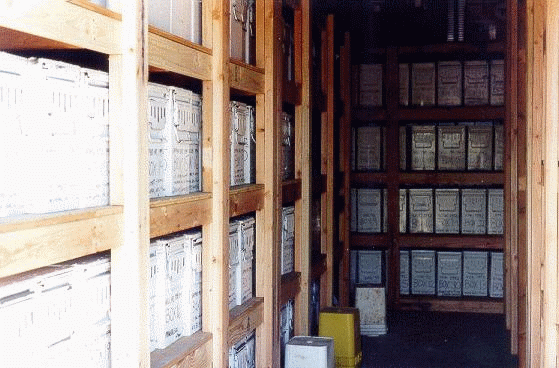Experiments in long-term ecosystem productivity:
The LTEP forestry research network in the Pacific Northwest
The
question that drives LTEP studies is: What factors, influenced directly or indirectly by management, most affect the long-term
productivity of the land?
Maintaining the "productivity of the land, " which includes producing commodities as well as other resources,
is required by law for managing federal land. A dominant effect of forest management has been to shorten
the time and space that early- and late-successional plant assemblages occupy sites (fig.1). The first factor
chosen for study was the sustained, day in and day out effects of different species and their litter on soil properties particularly
the relative effects of early successional, pioneering plants, late-successional plants and structure, and conifer
monocultures. We also hypothesized that removing biomass and woody debris can affect the site nutrient capital
and soil properties. Ecosystem responses and the processes underlying them are being studied in short- and long-term
experiments.
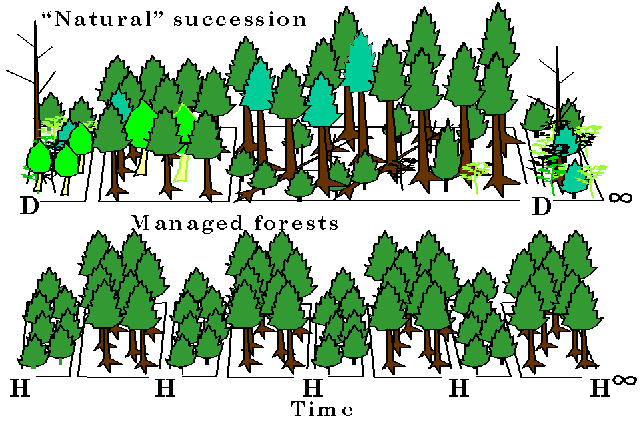
Figure 1. Traditional plantation forestry is thought to truncate both early- and late-successional stages.
A Long-Term Strategy For
a Long-Term Experiment
Asking durable questions.
We decided not to focus on currently popular management prescriptions,
which come and go quickly, as does interest in experiments designed around them. We tried to capture a range of
management actions likely to include future prescriptions, an approach more durable over the long-run.
Installing large measurement plots with very wide buffers. Large plots (1.5 ha) are needed to follow long-term development of trees as a
stand, to protect a central measurement plot and to allow for destructive sampling in buffers.
Associating short-term studies. To maintain interim support, we have short-term studies to address a wider range
of emerging issues and develop new methods useful in monitoring long-term experiments.
Surveying plots and building a local GIS. Permanent plot corners and 25-m grid points were installed to make them easy to
find and a local GIS helps manage activities through time.
Maintaining sample, photo, and data bases. Stored soil and plant samples and photos are considered as important as numeric
data stored on the Oregon State University, Forestry Sciences Lab database system. (fig. 2).
Figure 2. The LTEP sample-base storage facility with pretreatment soil samples preserved for future analyses.
Long-term,
large-scale experiment sites
Olympic Peninsula. This
site is on Washington Department of Natural Resources land, near Sappho, WA (Sappho site). Research plots lie at
about 100 m elevation, on a glacial outwash plain near the Sol Duc River on the northwestern part of the peninsula.
Abundant year-round rainfall (> 300 cm yr-1), mild climate, and fertile soils make this our most
productive site. Pre-treatment stands had 60-year-old naturally regenerated Douglas-fir with some Sitka spruce
and hemlock. Relatively homogeneous terrain and regrowth make the stands than at other sites. Experimental
treatments were completed in 1995.
Oregon Cascades. This
site is on the Willamette National Forest, Blue River Ranger District (Isolation Block site), and is affiliated
with, the HJ Andrews Experimental Forest and the LTER network. Research plots lie on mountainous terrain
at about 700 m elevation, underlain by volcanic soils. Rainfall is low during summer, and the total is less
than coastal sites (about 200 cm yr-1). Pre-treatment stands were naturally regenerated
Douglas-fir, about 80 years old, originating after a hot wildfire. Experimental treatments were completed
in 1997. Explore initial woody debris data
Coastal Siskiyous.
This site is on the Siskiyou National Forest, Chetco Ranger District (Siskiyou site). Research plots are
on mountainous terrain, 800 to 1100 m elevation, on a ridge 10 miles inland from the Pacific Ocean. Rainfall
is abundant during the winter but the site becomes arid and hot during the summer (about 250 cm yr-1). The pre-treatment 80- to 100-year-old Douglas-fir stands (with some knobcone
pine) regenerated naturally after hot wildfires. Experimental treatments were completed in 1997.
Oregon Coast Range. This
site is on the Siuslaw National Forest, Hebo Ranger District (Hebo site). Research plots lie on moderately mountainous
terrain with volcanic and sedimentary soils, at about 400 m elevation. Climate is intermediate between the
Olympic and Siskiyou sites. The pre-treatment stand was mostly Douglas-fir planted after a series of hot
wildfires, ending around 1930. The design was modified because of differing management objectives and site
conditions (see the Hebo Experiment). Experimental treatments were completed in 1998.
Washington Cascades.
Experimental treatments have not yet been applied on this site on the Wenatchee National Forest, Naches Ranger
District. Research plots lie on gentle terrain on volcanic soils at about 1000 m elevation. Climate
is the harshest (coldest and driest) at this site, which lies on the eastern side of the Cascades, east of Mount
Rainier. The initial stands are post-fire mixed conifers, dominated by Douglas-fir. Pretreatment sampling
was completed in 1994; experimental treatments will be applied in the next several years.
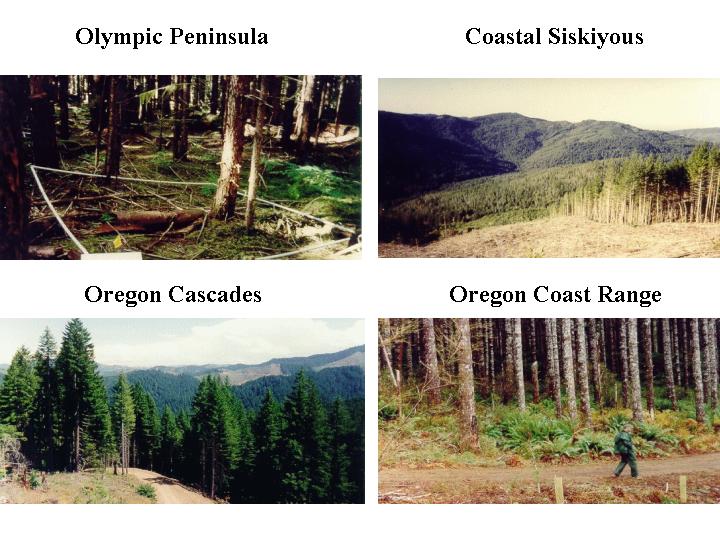
Long-term,
large-scale studies need full collaboration between scientists of many disciplines and between researchers and
land managers; this study is no exception. The Pacific Northwest Research Station to initiated a new research
program in 1988 on long-term ecosystem productivity in collaboration the National Forests and Ranger Districts,
Oregon State University, the Department of Natural Resources of Washington State, Western Ecology Branch of the
Environmental Protection Agency, University of Oregon, and Western Washington University. Together, we started
a program of short- and long-term, basic and applied research, including a 200-year experiment, covering about
120 to 250 ha on each of four sites in western Washington and Oregon (total area of 1650 ha).
The Integrated
Research Site Experiment
Analogous
to the effects of spatial scale in landscape ecology, some forest processes become manifest only at long temporal
scales. Research experiments that follow development for a few to 10 or 20 years cannot be safely extrapolated
over longer development periods; long-term experiments are needed to truly understand long-term phenomena.
This experiment seeks to evaluate 200-year effects of plant-assemblage and woody-debris changes on soil properties
linked to productivity, and on actual net primary productivity and diversity of these assemblages (fig. 3).
For example, we hypothesize that early-successional, pioneer plants build mineral soil organic matter and available
nutrient pools, and improve soil structure that might sustain growth of Douglas-fir at older ages. Late-successional
species are hypothesized to build litter layers and hold more nutrients in organic substrates. Fast-growing
Douglas-fir monocultures are hypothesized to reduce mineral soil organic matter.
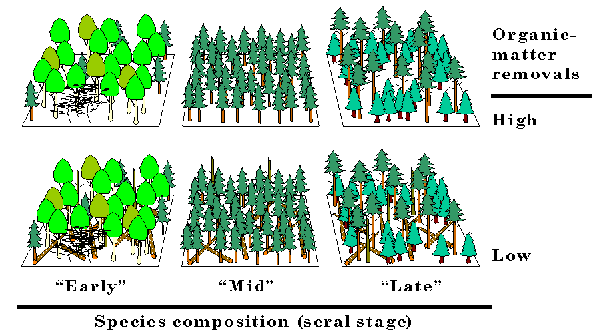
Figure 3. Experimental design for the LTEP Integrated Research Site experiment (control is not shown). Each site has 3 or more replications of treated areas 6 to 12 ha.
This design has been applied on the Olympic, OR Cascades, and Siskiyou sites
(fig. 4), but not yet in the WA Cascades. Pretreatment measurements include tree and understory species composition,
biomass, climate, social perception (photo monitoring and evaluation), and organic matter and nutrient content
from more than 1300 quantitative soil pits (stored in our sample-base). Additional measures of birds, small
mammals, amphibians, mycorrhizae, and fungal sporocarp abundance and diversity are completed on some sites.

Figure 4. Aerial photo of Siskiyou site with treatment overlays.
Short-term,
Retrospective, and Process Studies
Effects of plant assemblages
and processes thought to be associated with different assemblages are being studied in short-term, small-scale
experiments. Examples include:
Small plots study.
On the OR Cascades site, 6- by 6-m plots were established next to large plot treatments to study effects of added
litter from pioneer and late-successional plants, and Douglas-fir, as well as added woody debris, on soil properties
and growth of Douglas-fir seedlings. Homogenized soil blocks in mesh bags are being used to detect soil changes
in years 0 to 10. Other small-plot studies examine the 10-year effects of planted alders, maples, Douglas-fir,
and hemlock on soil properties, and subsequent growth of planted Douglas-fir in years 10 to 20.
Retrospective analysis of past early succession effects. A new tree dissection technique is being used to evaluate the extent that early-successional
plants dominated after disturbances that created the studied stands. Currently dominant Douglas-fir trees on the
Siskiyou site were suppressed for 40 years by growth of tanoak, ceanothus, and other shrubs.
Plant-driven weathering.
Two important pioneering species, red alder and lodgepole pine have been shown in greenhouse studies to greatly
speed weathering of primary minerals. These plants actually can grow well on ground basalt (up to 2 mm particles)
and water alone; Douglas-fir cannot. One effect of pioneer species in soils with weatherable primary minerals,
may be to increase availability of nutrients from weathering.
The Mount
Hebo Old-Growth Restoration Study
Treatments
on the OR Coast Range site were modified to address specific concerns of the Northwest Forest Plan, namely how
to grow old-growth from existing plantations and produce timber products. Pretreatment sampling, plot size, and
response measurements are the same. Long-term productivity concepts were included in the prescriptions, partly
paralleling the integrated-research-site treatments (fig. 5).
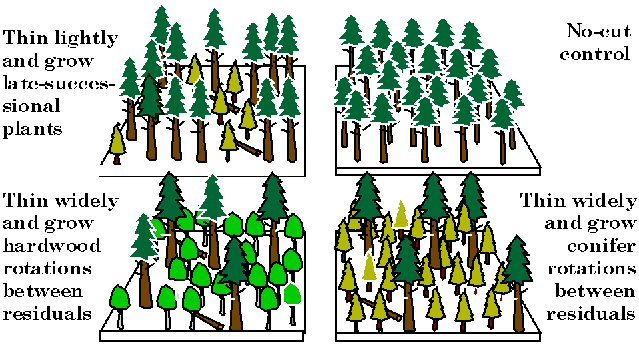
Figure 5. Mount Hebo study treatments, replicated 3 times.
New Approaches to Research and Management Collaboration
Large-scale,
long-term studies require land and long-term commitments by land owners. Research, especially on large federal
tracts, has not received much priority among the many competing forces influencing decisions. When managers
started asking questions like "Does management affect long-term productivity?" the answers clearly require
a much larger commitment to learning and at the scale of management so information can be better extrapolated across
diverse regions. This project has in effect been exploring new relations between managers and researchers
to simultaneously meet management and research objectives. Its initial successes have led to new concepts
of experimental, adaptive management.
You'
re Invited to Collaborate
We seek scientists interested in using our sites to answer important research questions. Our design, administration, and documentation is collaborator friendly. For example, past research activity is carefully assigned and documented, and destructive sampling is possible in stand buffers. Large volumes of stored soil and plant samples may be available for some studies as well. Please contact us: Robyn Darbyshire (rdarbyshire@fs.fed.us) or Bernard Bormann (bbormann@fs.fed.us).
